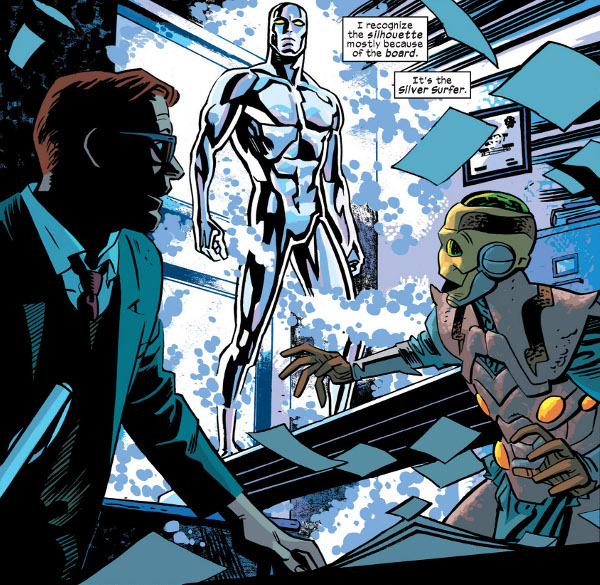Even though the Marvel Universe is vast and populated with many characters, it seems that certain heroes end up mostly associated with certain villain and allies. Clearly, this is because fans latch on to rivalries and enjoy seeing a villain with whom they are familiar. However, it does make you wonder why the Green Goblin, after being defeated by Spider-Man so many times, wouldn't try tackling Iron Fist. I like unexpected characters combinations, so it was pretty enjoyable when the Silver Surfer shows up in Daredevil #30, a unique interaction that I cannot recall previously seeing.
This issue has a relatively simple storyline. An alien named Ru'ach shows up at Matt Murdock's law office and claims to need his help. Shortly thereafter, the Silver Surfer arrives, announcing that he has been hunting Ru'ach. The Surfer, normally a pretty Zen dude, seems excessively aggressive and hostile, going so far as to slightly injure one of Murdock's staff members. This causes Murdock to flip, and he goes after the Silver Surfer, changing into his costume in the act. However, the out-of-character behavior of the Surfer is quickly explained. It turns out that Ru'ach is a member of a race that are expert manipulators, able to deduce one's deepest secrets and change the perceptions of those nearby to their own benefit.

I like the way writer Mark Waid introduces the hero-on-hero battle and then quickly dispenses with it, all the while providing a credible reason for the heroes to fight. I've grown tired of the hero vs. hero trend that has appeared more frequently since Civil War (DC's "Trinity War" is the latest incarnation). It's always struck me as odd that heroes would be so eager to fight another person who also has a long and public identity as a crime-fighter. Here, however, there's a clear explanation. It's not especially complex – it basically amounts to minor mind control. It works well enough.
The thing about Daredevil #30 is that it seems like a mostly stand-alone story, and so the plot movements are pretty swift. This means that a reader can jump into this issue without a lot of backstory. At the end of issue #30, the Surfer and Ru'ach are gone, not likely to return any time soon. This may make the plot mechanisms seem rudimentary. However, there is a lot going on here. Plus I enjoy Waid's straightforward approach, as many comics (such as Jonathan Hickman's Infinity) are so dense that they require a flowchart (literally).

Mark Waid has been taking a novel approach to Daredevil, making run lighter and more adventure based, and it's been a huge success. He still touches on some the dark issues within Murdock but without getting burdened by them. Waid has also taken a different approach to his storytelling. As I mentioned in my last review of Daredevil, he's often told short story arcs or even stand-alone stories that function well on their own. Yet over the course of many issues Waid slowly combines elements of those stories into a larger narrative. It's a really interesting approach to modern serialized comics.
Artist Chris Samnee, who recently won an Eisner for penciling, is a great fit for Waid's lighter tone. Samnee's colorful and expressive characters and layouts really make for a fun read. It's great to here see him able to draw the Silver Surfer. The shiny and glowing Surfer totally fits what Samnee does well. Samnee also has a gift for designing action sequences that look different. Whether it's putting the viewer's eye at an unusual angle (such as in the cover to #30) or showing the dynamism that these characters unleash when they fight or chase.

Although this issue seems to provide an unrelated distraction to recent Daredevil plotlines, I imagine this issue will ultimately prove important, in the way Waid has done in the past. Even taken on its own, the combination of Daredevil and the Silver Surfer, especially as drawn by Samnee, is a distraction well worth having.